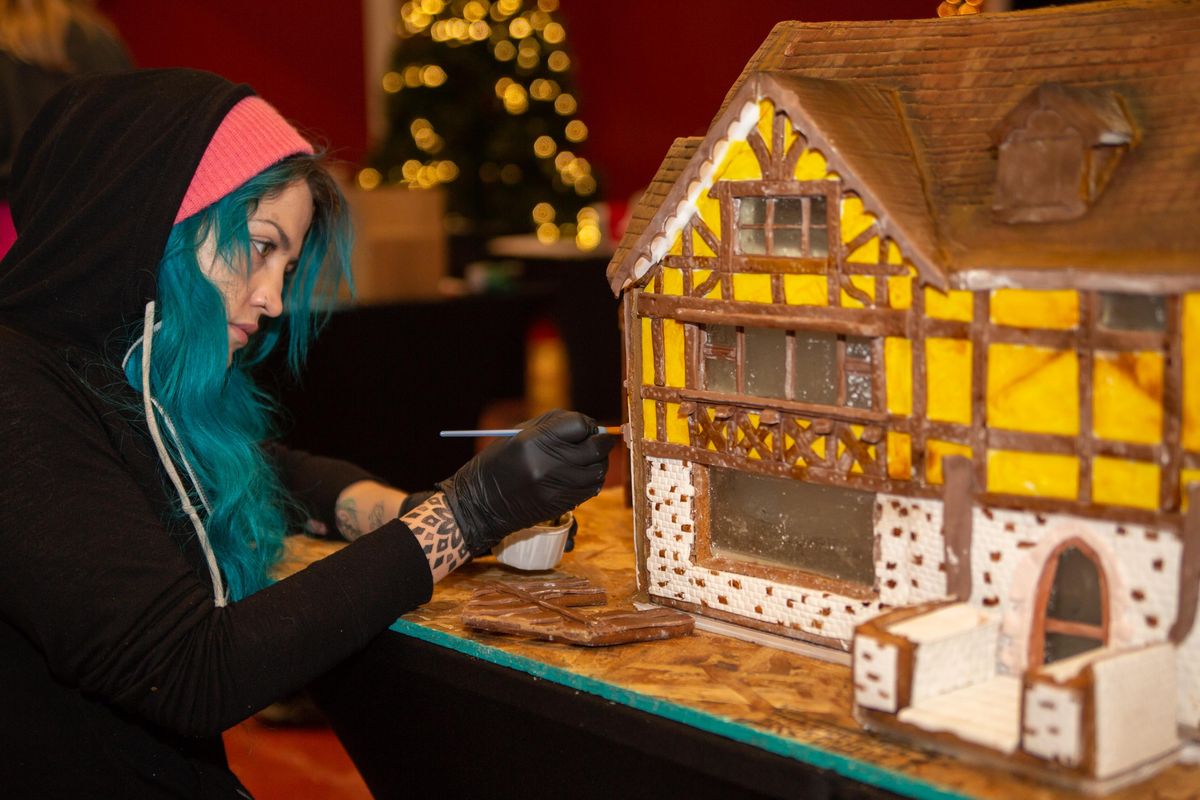Local chefs, community recreate historic Spokane landmarks in gingerbread

Spokane’s historical and cultural landmarks were recreated in gingerbread, fondant and royal icing Sunday as six local bakers, chefs and community members competed in the Christ Kitchen’s annual gingerbread build-off.
Each builder had three hours to construct and decorate their gingerbread creations.
Competition Judge Emma Woolley said every structure had to be at least 65 percent gingerbread, 3 feet wide, 3 feet long and 2 feet tall. All materials visible had to be edible. A trained chef and former competitor, Woolley said the gingerbread used to build the ornate structures is usually a little overcooked so it will stay together, and seasoned less than a gingerbread cookie because of the quantity of dough that goes into one house. She said most houses are also made with a combination of hot glue or icing to hold them together, but every team’s formula is unique.
“Every team does it a little differently,” she said.
The competition was stiff, but three teams walked away with awards. Sweet Frostings claimed the Judge’s Choice award with its rendering of a gingerbread Hutton Building, replete with small edible figurines of the building’s namesakes, suffragist May Arkwright Hutton and her husband Levi. Jessica Winfrey, one of the creators of the gingerbread Hutton Building, said they created the glasslike windows of the structure from a peanutless peanut brittle recipe. She said the other holiday features added to the building, Santa, his sleigh and reindeer, were created from fondant and modeling chocolate.
She said 98 percent of the workforce at Sweet Frostings is female and the business tries to get involved in projects that support women. The proceeds of the gingerbread build-off go to the Christ’s Kitchen’s organization, which offers work training for women in poverty.
The Board of Directors award went to the Washington Water Power gingerbread structure, built by employees of the Northern Quest Casino and Kalispel Tribe. Kristina Stephenson, a pastry chef at Northern Quest, said the gingerbread building used Jell-O in an innovative way and was developed with the help of an architect and laser-cutting company. Tony Janson, the architect who adapted the blueprints in the design of the structure, said they had every piece of gingerbread laser-cut.
The Washington Water Power gingerbread building used gelatin for the windows and blue Jell-O for water.
The Lilac Bakery, winner of the People’s Choice award, also used nontraditional techniques for its life-sized gingerbread Garbage Goat recreation, an homage to the iconic statue in Riverfront Park. The goat’s structure was mostly created with PVC pipe and Rice Krispies, chef Kira Cowell said, and the curved goat’s fur pieces of gingerbread were baked and then molded over pipes before they were assembled.
The Lilac Baker gingerbread goat also got a plaque to the real-life Garbage Goat creator, Spokane artist and nun Sister Paula Turnbull, who died in July.
Just like the real garbage goat, the gingerbread version can also eat small pieces of garbage, thanks to a vacuum cleaner inside of it.
Cowell said the goat was made mostly from gingerbread and decorated with royal icing, but the gingerbread itself was cooked in different ways so it could be molded into horns and other shapes and included spices, making it smell and taste good as well.
The other three gingerbread creations, the Big Barn Brewing Company gingerbread house, the Campbell House in Browne’s Addition and the Mount Spokane Vista House Lookout, also used a variety of techniques and decorating styles to accurately and creatively recreate the historic structures that inspired them.
Megan Gaines and Ricky Webster, creators of the Spokane Vista House Lookout gingerbread house, said gingerbread is their passion. Webster said he made his dream come true when he made a life-size gingerbread house last year, but he loves making all types of gingerbread creations.
Webster, who loved building gingerbread houses growing up, said people can’t help but think back to stories that involve candy houses, like Hansel and Gretel or Willy Wonka and the Chocolate Factory.
“You can’t help but place yourself in the house,” he said. “Like, ‘Oh, I wonder what it’s like in there.’ ”
Their gingerbread house was shingled with wafer paper and held together with royal icing. The trees decorating the fondant landscape were made from a variety of materials, including frosted Rice Krispies. The buildings were covered with a sugary snow and smelled like almonds, thanks to spritzes of almond extract that also gave the work a subtle shine.
Kim Kelly, executive director of Christ Kitchen, said the goal of the fundraiser was to raise $25,000. She said in the past, they have been able to raise that much through a raffle and by selling small gingerbread houses to families to decorate during the event.